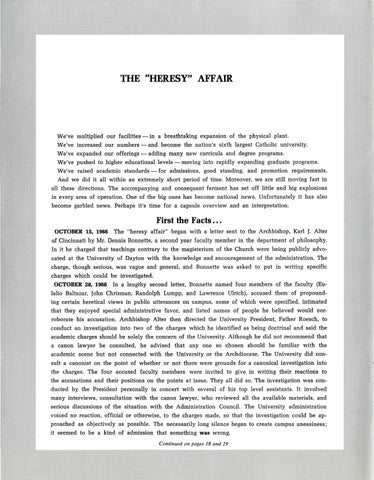THE "HERESY" AFFAIR
We've multiplied our facilities- in a breathtaking expansion of the physical plant. We've increased our numbers- and become the nation's sixth largest Catholic university. We've expanded our offerings- adding many new curricula and degree programs. We've pushed to higher educational levels- moving into rapidly expanding graduate programs. We've raised academic standards- for admissions, good standing, and promotion requirements. And we did it all within an extremely short period of time. Moreover, we are still moving fast in all these directions. The accompanying and consequent ferment has set off little and big explosions in every area of operation. One of the big ones has become national news. Unfortunately it has also become garbled news. Perhaps it's time for a capsule overview and an interpretation.
First the Facts ... OCTOBER 15, 1966
The "heresy affair" began with a letter sent to the Archbishop, Karl J. Alter
of Cincinnati by Mr. Dennis Bonnette, a second year faculty member in the department of philosophy. In it he charged that teachings contrary to the magisterium of the Church were being publicly advocated at the University of Dayton with the knowledge and encouragement of the administration. The charge, though serious, was vague and general, and Bonnette was asked to put in writing specific charges which could be investigated. OCTOBER 28, 1966 In a lengthy second letter, Bonnette named four members of the faculty (Eulalia Baltazar, John Chrisman, Randolph Lumpp, and Lawrence Ulrich), accused them of propounding certain heretical views in public utterances on campus, some of which were specified, intimated that they enjoyed special administrative favor, and listed names of people he believed would corroborate his accusation. Archbishop Alter then directed the University President, Father Roesch, to conduct an investigation into two of the charges which he identified as being doctrinal and said the academic charges should be solely the concern of the University. Although he did not recommend that a canon lawyer be consulted, he advised that any one so chosen should be familiar with the academic scene but not connected with the University or the Archdiocese. The University did consult a canonist on the point of whether or not there were grounds for a canonical investigation into the charges. The four accused faculty members were invited to give in writing their reactions to the accusations and their positions on the points at issue. They all did so. The investigation was conducted by the President personally in concert with several of his top level assistants. It involved many interviews, consultation with the canon lawyer, who reviewed all the available materials, and serious discussions of the situation with the Administration Council. The University administration voiced no reaction, official or otherwise, to the charges made, so that the investigation could be approached as objectively as possible. The necessarily long silence began to create campus uneasiness; it seemed to be a kind of admission that something was wrong. Continued on pages 18 and 19
